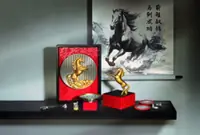A drawing by 'Mykola Kostenko' is part of the 'War Diaries' exhibition in Amsterdam. Photo: AP
The city where Anne Frank wrote her World War II diary while hiding with her family from the brutal Nazi occupation is hosting an exhibition about the Ukraine war with grim echoes of her plight more than three quarters of a century later.
The exhibition that opened at Amsterdam City Hall recently offers a vision of the war in Ukraine as experienced by children caught in the devastating conflict.





